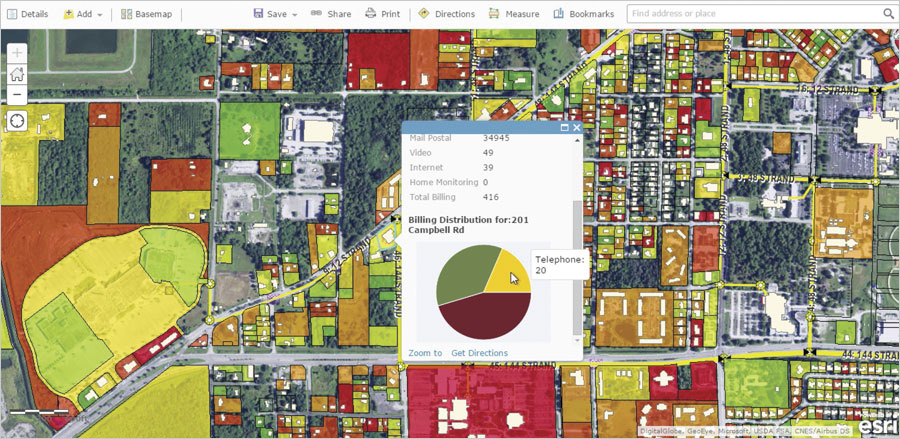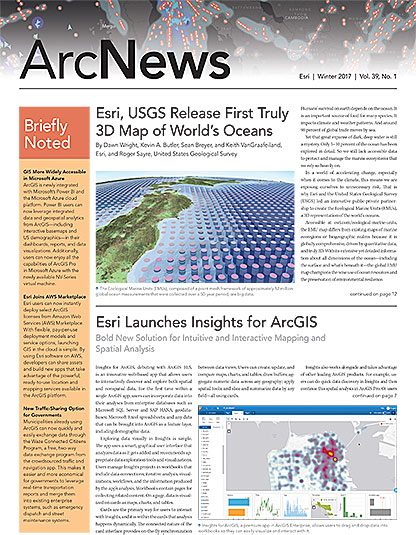Telecommunications Company Develops Spatially Enabled Customer Engagement Strategy
Horry Telephone Cooperative (HTC), based in South Carolina, is the largest telecommunications cooperative in the United States. HTC has a wide range of offerings, from telephone service and high-speed Internet to digital cable, wireless service, and security systems.
With a diversifying customer base, the cooperative wanted to streamline how it offered and delivered services to members and new customers. With this in mind, HTC made its internal information accessible from one place: the ArcGIS platform.
Paring Down Internal Communication
Previously, HTC managed its operations using tabular spreadsheets and apps built in-house. Information was stored in multiple systems. While employees could ultimately find what they needed, having a system that didn’t support interdepartmental collaboration meant it took longer than necessary—sometimes days—to find the right data.

To make internal communication more efficient, HTC took its information about customers, operations, and marketing—which resided in multiple systems—and put it into a geodatabase. This not only enabled employees to pull the critical information they needed directly from the system, but it also gave the data a spatial foundation, allowing staff to visualize this information in ways that weren’t possible before.
“You get so much more when you present that data on the map than you do just looking at spreadsheets,” said Sid Blackwelder, HTC’s chief information officer.
Engaging New Customers Spatially
Before HTC had access to ArcGIS and, specifically, Esri Business Analyst Online (now called Esri Business Analyst Web App), developing marketing strategies for new markets was a time-consuming manual process. Obtaining reliable demographics for each prospective market and campaign required searching through multiple systems, examining outside data sources, and building complex spreadsheets. With Business Analyst Web App, however, marketing staff can visually assess demographics, household information, and other consumer data almost instantly using highly informative, interactive maps that are easy to understand and use.
“Rather than looking at a spreadsheet of just a lot of data, [ArcGIS] allows me to really build a case for a particular geographic target and helps us make informed decisions [about] where we need to go next,” said sen-ior marketing coordinator Jessica Strickland.
By mapping new markets, staff can understand potential customers’ preferences, lifestyles, and media sources. The HTC marketing department can also use spatial analysis to identify new markets to target with customized messages and offers.
With this spatially enabled customer engagement strategy, sales teams can check specifics for each home, such as its service history and available rates. Members of the sales team can also see if homeowners are existing customers or prospective patrons and alter their sales messages accordingly.
“We can [quickly] tailor each customer message based upon the history that we built through ArcGIS,” said Brent Groome, the chief executive of marketing, economics, and strategic initiatives for HTC.
Using ArcGIS, the marketing department at HTC can visually monitor campaign results. They can identify patterns and trends and pinpoint any changes and opportunities. This allows them to understand in real time what is working, where they can improve, and which corrective actions to apply.
Enhancing Field Capabilities
It was critical for HTC employees to be able to instantly share information across the platform both internally and externally from multiple devices.
“It’s vitally important to share information [with other] parts of the organization so everybody is on the same page and understands the goals and how to attain the most effective results,” said Jon Tyler, HTC’s chief executive of sales and customer service.
Employees with no previous GIS experience are accessing geospatial information in the ArcGIS platform and discovering new, faster ways of solving old problems.
Engineers can determine where to invest in network expansions by identifying geographic patterns in customer service requests and comparing where customers live versus where they work. While out in the field, they can also propose facility upgrades with easy-to-understand maps that show details such as demographics and service request history.
“Esri gave field engineers the ability to do something that they couldn’t do before, or with anything else out there, because they could take the information into the field and say, ‘This is where I want to put this, and here are the details behind it,'” said Edward Gause, director of information services operations. “They can pull that information up and manipulate it on the spot.”

